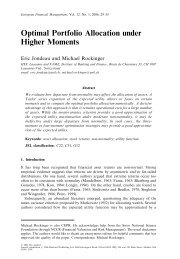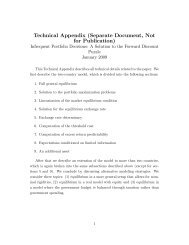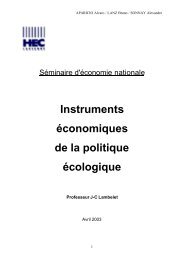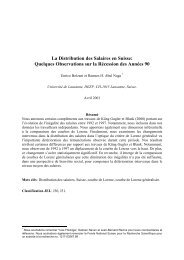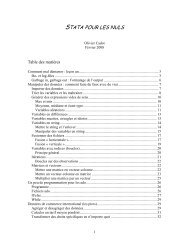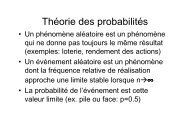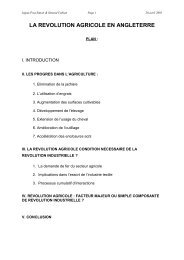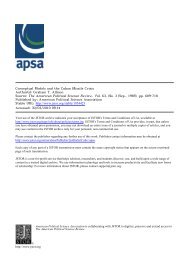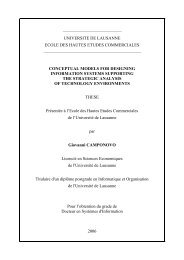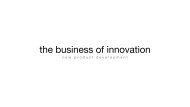The Business Model Ontology - a proposition in a design ... - HEC
The Business Model Ontology - a proposition in a design ... - HEC
The Business Model Ontology - a proposition in a design ... - HEC
Create successful ePaper yourself
Turn your PDF publications into a flip-book with our unique Google optimized e-Paper software.
<strong>The</strong> <strong>Bus<strong>in</strong>ess</strong> <strong>Model</strong> <strong>Ontology</strong> - a <strong>proposition</strong> <strong>in</strong> a <strong>design</strong> science approach<br />
Elements<br />
Connections<br />
Name<br />
Core Strategy<br />
Strategic<br />
Resources<br />
Customer<br />
Interface<br />
Value<br />
Network<br />
Configuration<br />
Customer<br />
Benefits<br />
Company<br />
Boundaries<br />
Description<br />
This element def<strong>in</strong>es the overall bus<strong>in</strong>ess mission, which captures what the<br />
bus<strong>in</strong>ess model is <strong>design</strong>ed to accomplish. Further, it def<strong>in</strong>es the product and<br />
market scope and specifies <strong>in</strong> what segments the company competes. F<strong>in</strong>ally, it<br />
outl<strong>in</strong>es how the firm competes differently than its competitors.<br />
This element conta<strong>in</strong>s the core competencies of a firm. In other words, what a firm<br />
knows, its skills and unique capabilities. <strong>The</strong>n it specifies the strategic assets, such<br />
as <strong>in</strong>frastructure, brands and patents. Last, this element outl<strong>in</strong>es the core processes<br />
of the firm; it expla<strong>in</strong>s what people actually do.<br />
This element is composed of fulfillment and support, which refers to the way the<br />
firm goes to market and reaches its customers (e.g. channels). Second, <strong>in</strong>formation<br />
and <strong>in</strong>sight def<strong>in</strong>es all the knowledge that is collected from and used on behalf of<br />
the customer. Third, the relationship dynamics refer to the nature of the <strong>in</strong>teraction<br />
between the producer and the customer. F<strong>in</strong>ally, the pric<strong>in</strong>g structure expla<strong>in</strong>s what<br />
you charge the customer for and how you do this.<br />
<strong>The</strong> value network outl<strong>in</strong>es the network that surrounds the firm and complements<br />
and amplifies the firm’s resources. It is composed of suppliers, partners and<br />
coalitions. Partners typically supply critical complements to a f<strong>in</strong>al product or<br />
solution, whereas coalitions represent alliances with like-m<strong>in</strong>ded competitors.<br />
This connection refers to the unique way <strong>in</strong> which competencies, assets, and<br />
processes are comb<strong>in</strong>ed and <strong>in</strong>terrelated <strong>in</strong> support of a particular strategy.<br />
This l<strong>in</strong>k <strong>in</strong>termediates between the core strategy and the customer <strong>in</strong>terface. It<br />
def<strong>in</strong>es the particular bundle of benefits that is actually be<strong>in</strong>g offered to the<br />
customer.<br />
This bridge refers to the decisions that have been made about what the firm does<br />
and what it contracts out the value network.<br />
Table 12: Hamel’s (2000) bus<strong>in</strong>ess model components<br />
Like Hamel (2000), L<strong>in</strong>der and Cantrell (2000) propose a comprehensive approach to bus<strong>in</strong>ess<br />
models. Further, they stress the fact that many people speak of bus<strong>in</strong>ess models when they actually<br />
only mean a specific component of a bus<strong>in</strong>ess model. <strong>The</strong>y list the follow<strong>in</strong>g components: the pric<strong>in</strong>g<br />
model, the revenue model, the channel model, the commerce process model, the Internet-enabled<br />
commerce relationship, the organizational form and the value <strong>proposition</strong> (see Figure 17).<br />
33




